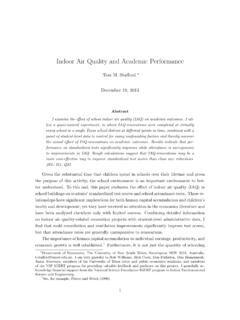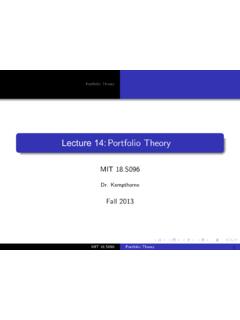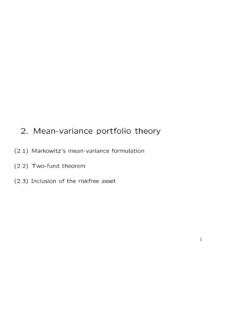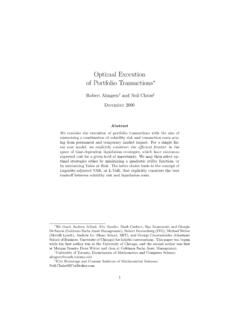Transcription of Capital Asset Pricing Model - UNSW
1 Capital Asset Pricing ModelEcon 487 Outline CAPM Assumptions and Implications CAPM and the Market Model Testing the CAPM Conditional CAPMCAPM Readings Zivot, Ch. 8 (pp. 185-191) (page # s at top of page) Benninga, Ch. 10 (pp. 221-228) Perold (2004) (pp. 288-289)What is the CAPM? Theory of Asset price determination for firms Based on portfolio theory and Market Model The only thing that matters is Beta (co-movement with the market) Alternative to valuation theory for individual firmsCAPM Assumption #1 Many investors who are all price takers , financial markets are competitive Returns provide full summary of investment opportunitiesCAPM Assumption #2 All investors plan to invest over the same time horizon Abstracts from heterogeneity in investors ( , risk averse have different time preferences than the risk tolerant)
2 Helps address any deviations from CER modelCAPM Assumption #3 No distortionary taxes or transaction costs Clearly a false assumption (debt vs. equity)CAPM Assumption #4 All investors can borrow/lend at same risk-free rate Again, clearly false But we can consider Zero-Beta version of CAPM with short-salesCAPM Assumption #5 Preferences: Investors only care about expected return (like) and variance (dislike) Consistent with portfolio theory and CER Model under Normality False if assets have different co-movements with state of the economy ( , recession vs. boom)CAPM Assumption #6 All investors have same information and beliefs about distribution of returns , CER Model , with same beliefs about parametersCAPM Assumption #7 Market portfolio that determines Beta consists of all publicly traded assetsImplication #1 Investors will use Markowitz algorithm to determine same set of efficient portfoliosImplication #2 Risk-averse investors will put most of their wealth in risk-free Asset Risk-tolerant investors will put most of their wealth in risky assets In equilibrium.
3 No net borrowing=> risk-free rate and tangency portfolioImplication #3 Tangency portfolio = market portfolio Note: implies positive weights on all assets in tangency portfolio , even allowing for short salesImplication #4 Market portfolio is mean-variance efficient , highest Sharpe RatioImplication #5 Security Market Line (SML) Pricing holds for all assets and portfolios , expected return on Asset i is fully determined by three things: risk for Asset iSecurity Market Line (SML) ! E[Rit]=rf+"i,M(E[RMt]#rf) where i refers to an individual Asset or portfolio Beta- portfolio !
4 E[Rpt]=(1"xm)rf+xmE[RMt]=rf+xm(E[RMt]"rf ) Set ! xm="i,M for a given Asset i to compare ! E[Rpt] on Beta- portfolio to ! E[Rit]. Log-Linear Present Value Relationship ! pt=c1"#+Et#j"1(1"#)dt+jj=1$%& ' ( ( ) * + + "Et#j"1rt+jj=1$%& ' ( ( ) * + + Market Model ! Rit="i+#i,MRMt+$it ! "it~iidN(0,#"i2) ! cov(RMt,"it)=0 Subtract ! rf from both sides ! Rit"rf=#i"rf+$i,MRMt+%it Add and subtract ! "i,Mrf from right-hand-side: ! Rit"rf=#i"(1"$i,M)rf+$i,M(RMt"rf)+%it IstheCAPMU seful? ,wecanexaminewhetherrealworldassetprices andinvestorportfoliosconformtothepredict ionsofthemodel,ifnotalwaysinastrictquant itativesense, ,evenifthemodeldoesnotdescribeourcurrent worldparticularlywell,itmightpredictfutu reinvestorbehavior forexample,asaconse-quenceofcapitalmarke tfrictionsbeinglessenedthroughfinanciali nnovation, , (market) , ,optimalmanagementofcapitalgainstaxesinv olvesearlyrealizationoflossesanddeferral ofcapitalgains,andsotaxableinvestorsmigh treactverydifferentlytochangesinassetval uesdependingonwhentheypurchasedtheasset( Constantinides,1983).))
5 Nevertheless, , , (SML)Beta of market ! returnMarketportfolioIn equilibrium, allassets plot on the SMLEM " rf ! slope of SMLEMrf 18 JournalofEconomicPerspectivesIntuition for CAPM Investors should not be compensated for diversifiable , Beta=0 If expected return > risk-free, borrow at risk-free to buy zero-beta Asset If expected return < risk-free, sell zero-beta Asset short and buy more risk-free Both cases imply higher portfolio return without higher risk (at the margin)Equilibrium for Beta=0 Risk-free rate and price of zero-beta Asset adjust to equate expected return and risk-free rate , if expected return < risk-free rate, price falls today to make future expected returns higher recall log-linear present-value relationship between price and expected returnsSecurity Market Line (SML) !
6 E[Rit]=rf+"i,M(E[RMt]#rf) where i refers to an individual Asset or portfolio Beta- portfolio ! E[Rpt]=(1"xm)rf+xmE[RMt]=rf+xm(E[RMt]"rf ) Set ! xm="i,M for a given Asset i to compare ! E[Rpt] on Beta- portfolio to ! E[Rit]. Log-Linear Present Value Relationship ! pt=c1"#+Et#j"1(1"#)dt+jj=1$%& ' ( ( ) * + + "Et#j"1rt+jj=1$%& ' ( ( ) * + + Market Model ! Rit="i+#i,MRMt+$it ! "it~iidN(0,#"i2) ! cov(RMt,"it)=0 Subtract ! rf from both sides ! Rit"rf=#i"rf+$i,MRMt+%it Add and subtract ! "i,Mrf from right-hand-side: ! Rit"rf=#i"(1"$i,M)rf+$i,M(RMt"rf)+%it , Beta=1 If expected return > market, sell other assets to buy high-return Asset If expected return < market, sell Asset to buy more of market portfolio Both cases imply higher portfolio return without higher risk (at the margin)))
7 Prices adjust to bring about equilibriumIn general Investors can choose mix of risk-free Asset and market portfolio to achieve any desired expected return => Beta portfolio Weight on market portfolio is Beta in SML If expected return on Asset i is different than SML, prices will adjust as investors buy/sell Beta portfolio and Asset Market Line (SML) ! E[Rit]=rf+"i,M(E[RMt]#rf) where i refers to an individual Asset or portfolio Beta- portfolio ! E[Rpt]=(1"xm)rf+xmE[RMt]=rf+xm(E[RMt]"rf ) Set ! xm="i,M for a given Asset i to compare ! E[Rpt] on Beta- portfolio to ! E[Rit].
8 Log-Linear Present Value Relationship ! pt=c1"#+Et#j"1(1"#)dt+jj=1$%& ' ( ( ) * + + "Et#j"1rt+jj=1$%& ' ( ( ) * + + Market Model ! Rit="i+#i,MRMt+$it ! "it~iidN(0,#"i2) ! cov(RMt,"it)=0 Subtract ! rf from both sides ! Rit"rf=#i"rf+$i,MRMt+%it Add and subtract ! "i,Mrf from right-hand-side: ! Rit"rf=#i"(1"$i,M)rf+$i,M(RMt"rf)+%it IstheCAPMU seful? ,wecanexaminewhetherrealworldassetprices andinvestorportfoliosconformtothepredict ionsofthemodel,ifnotalwaysinastrictquant itativesense, ,evenifthemodeldoesnotdescribeourcurrent worldparticularlywell,itmightpredictfutu reinvestorbehavior forexample,asaconse-quenceofcapitalmarke tfrictionsbeinglessenedthroughfinanciali nnovation, , (market) , ,optimalmanagementofcapitalgainstaxesinv olvesearlyrealizationoflossesanddeferral ofcapitalgains,andsotaxableinvestorsmigh treactverydifferentlytochangesinassetval uesdependingonwhentheypurchasedtheasset( Constantinides,1983).))
9 Nevertheless, , , (SML)Beta of market ! returnMarketportfolioIn equilibrium, allassets plot on the SMLEM " rf ! slope of SMLEMrf 18 JournalofEconomicPerspectivesKey Point Even if there is an implicit present-value Model of stock price determination, there is no need to forecast future dividends for firm i Given SML, all that matters for Pricing firm i is Beta ( , responsiveness to market return) Easier to estimate Beta than to forecast future dividendsCAPM and the Market Model Market Model is a statistical Model CAPM is a theory that places parameter restrictions on Market Model Consider excess return version of Market ModelSecurity Market Line (SML) !
10 E[Rit]=rf+"i,M(E[RMt]#rf) where i refers to an individual Asset or portfolio Beta- portfolio ! E[Rpt]=(1"xm)rf+xmE[RMt]=rf+xm(E[RMt]"rf ) Set ! xm="i,M for a given Asset i to compare ! E[Rpt] on Beta- portfolio to ! E[Rit]. Log-Linear Present Value Relationship ! pt=c1"#+Et#j"1(1"#)dt+jj=1$%& ' ( ( ) * + + "Et#j"1rt+jj=1$%& ' ( ( ) * + + Market Model ! Rit="i+#i,MRMt+$it ! "it~iidN(0,#"i2) ! cov(RMt,"it)=0 Subtract ! rf from both sides ! Rit"rf=#i"rf+$i,MRMt+%it Add and subtract ! "i,Mrf from right-hand-side: ! Rit"rf=#i"(1"$i,M)rf+$i,M(RMt"rf)+%it Excess-Return Market Model !))










